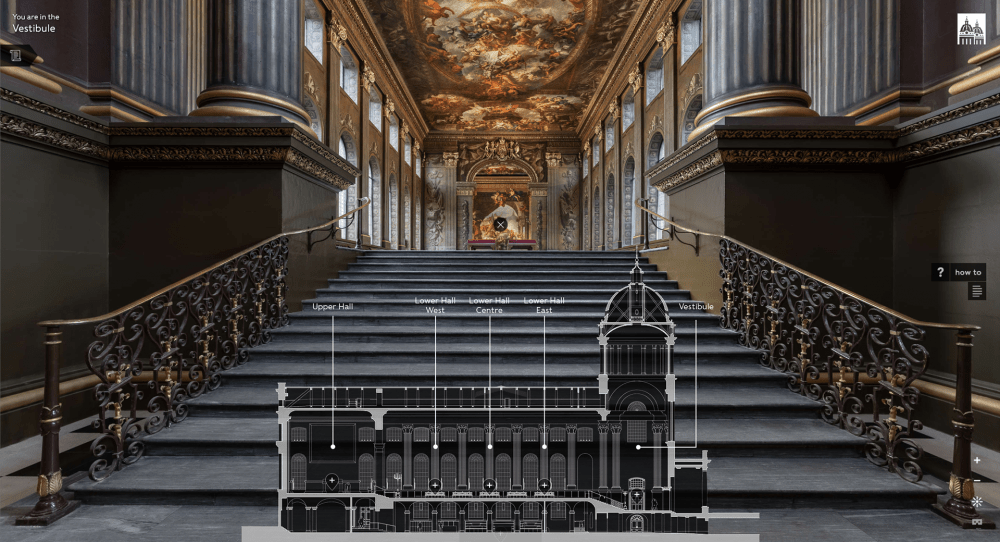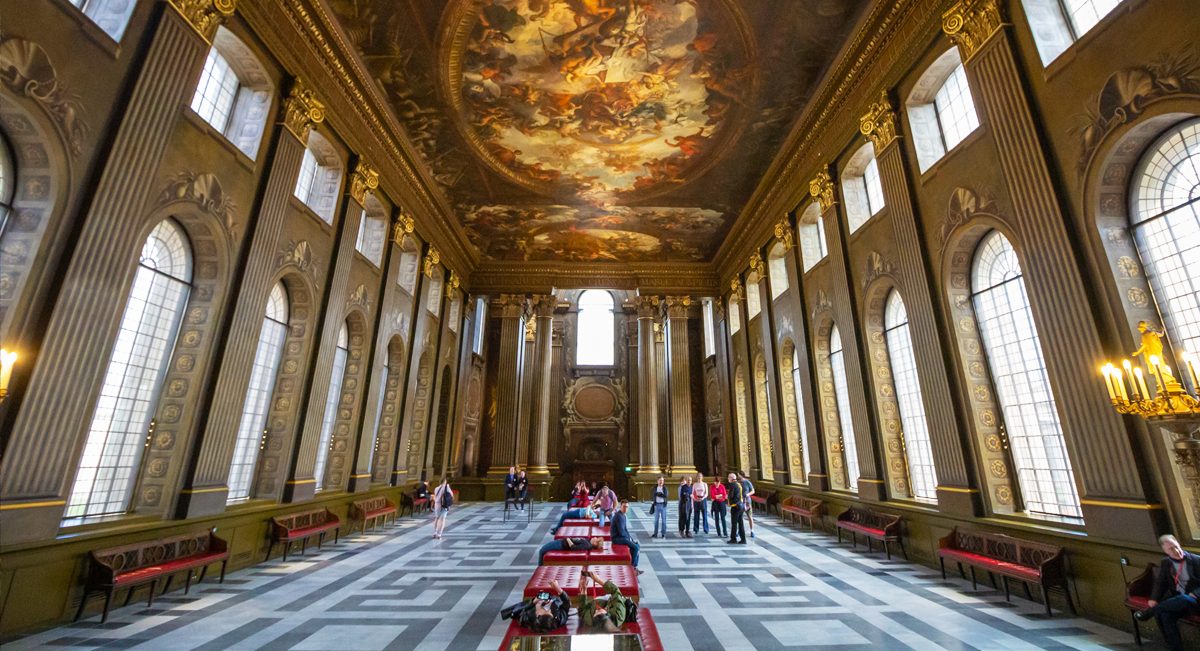
7th May 2020
Virtually There – How to Create Effective 360° Virtual Tours
With holiday and leisure plans on hold for the foreseeable future, it’s little wonder that Google saw a 100% spike in searches for virtual cultural experiences in the month of March with visitors looking to connect and engage with cultural sites from home.
But what makes a virtual tour stand out, and what can you do to get more engagement from digital audiences?
We’ve taken a look at some of the best digital tours in the market, from Buckingham Palace and St Paul’s Cathedral to emerging favourites such as the Painted Hall at the Old Royal Naval College (included in Britain’s Best 360 Tours). There are many lessons to be learned from these examples and in this article, we will set out some best–practice tips.

The Painted Hall, Greenwich – Picture: ATS
When we think of virtual tours, we normally think of a traditional 360° tour experience like the Buckingham Palace tour that was created in 2016. However, today’s more digitally sophisticated audiences desire more interaction and the Painted Hall at Old Royal Naval College is the perfect example.
The Painted Hall 360° Virtual Tour’s stunning ultra-high definition gigapan images are what stand out the most, delivering a high-quality look and feel – users can explore and zoom in on brushstrokes and tiny details of the magnificent ceiling. The virtual tour also includes 3D audio soundscapes, interactive hot spots, text transcripts and a British Sign Language version. Users can roam the Painted Hall freely or activate an automatic highlights tour. Read more about the project here.
Here are some of our top tips for creating the perfect virtual tour
- What is the purpose of this project – we like to ask clients: “in 12 months after launch, what would deem this a successful project?”. (Visits / shares / engagement) – think about and measure the criteria by which you are designing the virtual tour for.
- Closely aligned to the first point – who is this for? Who are your audiences and what are they looking for in this type of experience? Do you need to create versions for types of audiences (adult, families, international), or have a variety of interpretive styles in the single design. Be careful not to be everything to everyone, this approach can dilute some great ideas.
- What platform should you use for your virtual tour? Native app, web app or website? We’d suggest you keep this question in mind as you work through this list. Two main questions (for Museums & Cultural sites) will be which is the most accessible for your visitors (it needs to be easy for your visitors to access and share), and which is most financially sustainable (not just in initial design & build, but hosting and support).

Navigation in the Vestibule
- Set the scene to the experience and don’t assume technical knowledge of the visitor – think about opening with a high-quality introduction video to tease the highlights and ease-of-use (use this video as promotional content too).
- Digital wayfinding (or user experience) is as important in the digital world as it is in the physical – make sure the interface and the tour is easy to follow and consider the use of graphics, maps, audio and text to guide your visitors through the experience.
- Content should be engaging, entertaining and ideally suitable for all age groups. Explore the use of copy, audio descriptions, video and background sounds to create a truly immersive experience.

A closer look at the ceiling
- Give the visitor a purpose to be there, a short / bite size, high-quality virtual tour will give visitors a better user experience than a large “able to go anywhere/everywhere” with little or low-quality content that creates visitor fatigue and disorientation.
- Consider giving visitors a goal to complete in the virtual tour. This can be as simple as ‘find a particular item’ but that simple extra level of engagement will increase the time spent on the tour, which in turn, improves your SEO ranking.
- Use the tour to gain publicity. A unique digital tour with memorable and distinctive content will help it to stand out and catch the attention of leisure and family publications.

BSL version of the virtual tour
- Promote your virtual tour across social media channels and spread your posts out to highlight different aspects of the tour each day.
- Make sure that visitors can easily share and link to the virtual tour (ideally from within the tour experience) so it can be easily promoted across social media channels.
- Create a tour that is consistent with your brand. Apply brand guidelines at all times and avoid generic templates. Although this is a digital experience, you will want potential future visitors to conclude their tour with a positive perception of your institution.
Reflecting on their experience of creating a virtual tour, Claire Kirk of the Old Royal Naval College is delighted with their tour of the famous Painted Hall:
“We are thrilled that, for the first time, people can get up close to this magnificent Baroque interior from the comfort of their own homes and from all over the world. Zooming in our Painted Hall ceiling in ultra-high-resolution reveals details you can’t see from the ground – fire breathing serpents, glistening jewels and bubble blowing cherubs. With this new tool everyone can appreciate not only the mastery of Thornhill’s brushwork but also the incredible quality of the conservation works recently carried out. It’s like a scaffolding tour but with your feet firmly on the ground!”
Try out the Painted Hall 360° Virtual Tour here.
If you would like to learn more about creating a virtual tour, get in touch with us to discuss your options on how best to present your offering to potential future audiences.


